RIGHT TURN ONLY!!
Moon Festival
by Carlo Santos,

All right, we've got the NBA season back after all! This makes me a very happy basketball fan. So happy, in fact, that I reviewed Slam Dunk this week! Hooray!
AT FULL MOON
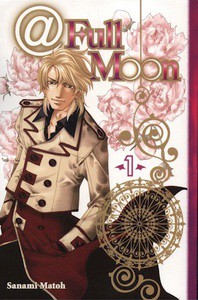
Vol. 1
(by Sanami Matoh, Kodansha Comics, $10.99)
FROM THE BACK COVER:
"Half-vampire, half-werewolf Marlo undergoes a very special transformation when exposed to the full moon—HE becomes a SHE! Finally married to the handsome, womanizing vampire David, Marlo's figuring it all out. That is, until a rich werewolf and a rival vampire fall for the moonlight missus!"
EVIDENCE FOR:
Romances supposedly become less interesting when main couple finally gets together—but not in At Full Moon, where marriage is merely a new obstacle to would-be adulterers. Also, unlike a certain very popular "paranormal romance" franchise, this series takes all the vampire and werewolf brouhaha and plays it for laughs. Rival vampire Clive and his pint-sized witch accomplice spend just as much time bickering as they do trying to win Marlo over, and even more bizarre in his social graces is werewolf Chris, who not only invites Marlo out on dates but says "Your husband can come along too"—as if this somehow wouldn't be ridiculously awkward. The comedy only gets more screwy in the volume's third act, when a magical enchantment on Marlo brings all the romantic rivals together for a slapstick showdown. As always, the artwork focuses on making each of the leading males as attractive as possible, and Marlo in female form has her charms too, with all manner of frilly dresses and floral backgrounds. The energy of the characters when they fly into angry fits also provides visual entertainment.
EVIDENCE AGAINST:
In theory, romantic polygons and bumbling characters are both funny things, so a bumbling romantic polygon should be super-funny. But At Full Moon's attempt to bring these elements together falls hopelessly flat, only emphasizing the worst aspects of romantic comedies. The new characters in this story never display any real, concrete motivation for being attracted to Marlo: they like her just for the sake of liking her, which is the worst reason ever. And since they're so incompetent, one never gets the impression that they would be legitimate contenders for Marlo's affections anyway. The comedy aspect ends up being just as shallow, with most of the "jokes" being the characters yelling at each other as loudly as possible. Sometimes they also do pointless, impulsive things like moving away to America for a few weeks—which serves only to pad out the plot. The visuals are also mostly a low-budget effort: the pseudo-gothic setting of David and Marlo's new hometown is too bland to be convincing, like a cardboard simulation of central Europe rather than the real thing. The lack of delicacy or variety in the linework also keeps the art from being anything other than throwaway gag material.
FINAL VERDICT:
It might be a justified purchase if you wanted to continue with Matoh's Full Moon series, but otherwise, it's too poorly constructed to be anything other than a D+.
DOROHEDORO
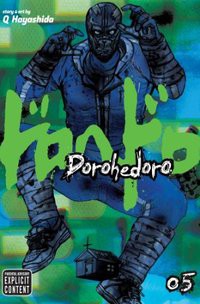
Vol. 5
(by Q Hayashida, Viz Media, $12.99)
FROM THE BACK COVER:
"Everyone is looking for that special someone ...
Convinced that Risu is the key to his past (and his head), Caiman heads to the Sorcerers' dimension on his own. While he's tracking down Risu, he finds the Sorcerers getting ready for 'Blue Night,' a festival where Sorcerers find their partners. Meanwhile, Risu is looking for his old partner Aikawa to see what he might know about the people who killed him. Shin and Noi are both being hunted by Sorcerers who've long coveted them as partners. En is relentlessly hunting a Sorcerer who can manipulate time. And Fujita's looking for ... well, any partner who will have him."
EVIDENCE FOR:
If there's one thing Dorohedoro consistently succeeds at, it's being as weird and wonderful as possible. Where else are you going to see a giant cockroach engage a humanoid mushroom in combat, or a running gag where the lead character keeps being run over by a restaurant deliveryman on a flying broom? It's not just the strange themes and imagery that make this series stand out, but also the way entire genres unexpectedly come together: what is ostensibly a cyberpunk story about a lizard-headed man seeking revenge suddenly becomes a quirky slice-of-life chronicle when Caiman tries to survive in the Sorcerers' world. Even the bad guys get in on the genre-bending, with En's gang becoming lovable goons as they contemplate future prospects and past friendships (the flashback about Shin and Noi is paced almost like a buddy comedy, of all things). But it takes only one look at the sketchy lines, grimy buildings, and bizarre creatures in the art to remind us that this world is a dangerous one, and the violent fights—severed limbs, gory deaths—further drive the point home. Between that and the action-packed, head-spinning cliffhanger, plenty of excitement awaits in this volume.
EVIDENCE AGAINST:
People come to Dorohedoro for the crazy ideas and unique art—but they certainly don't come for a good plot. Hayashida's feats of the imagination are wasted on meandering pacing, hard-to-understand characters, and an almost Mad Libs method of advancing the storyline. Whenever En's gang of Sorcerers are the focus, for example, they always show up in a pack, wearing those ugly masks—so trying to understand their motivations and personalities individually becomes a confusing exercise. (Even a flashback that explains the relationship between Shin and Noi ends up as a side story more than anything else.) And when Caiman's search for the mysterious Risu suddenly becomes a part-time workplace comedy, that leaves a lot of readers tapping their feet and wondering when the actual story is going to start. A similar problem happens on the "normal human" side of the world, where Nikaido and her gyoza café become this stagnant point where the characters wonder to themselves, "I wonder what Caiman's up to?" every 30 pages or so. By the time the story does pick up and important confrontations start to happen, it's already the last chapter—so what was the point of everything else that happened in this volume anyway?
FINAL VERDICT:
Absolutely brilliant and imaginative—unless you're actually trying to follow the story, which wanders inexplicably until it lands on a C.
HOUSE OF FIVE LEAVES
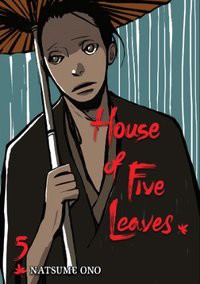
Vol. 5
(by Natsume Ono, Viz Media, $12.99)
FROM THE BACK COVER:
"As Yaichi's pursuers draw closer, Yagi also steps up his investigation into the man and his past. Masa, who's caught between them, becomes privy to secrets about Yaichi unknown even to the original members of the Five Leaves. Matters grow even more complicated as Masa's younger brother becomes increasingly entangled in his difficulties back home. Slowly but surely, the pressure on the Five Leaves mounts."
EVIDENCE FOR:
House of Five Leaves pulls off the supreme challenge of any period drama: making the setting itself as attractive as the characters and storyline. Between the artfully sketched trees, the historically accurate houses, and the loose, almost-calligraphic sense of line, these visuals a genuine trip to old-time Japan. The characters' expressions, too, prove that Ono continues to refine her illustration skills as she captures the series' shifting moods. We see Masa and company grimacing, contemplating, and occasionally joking around as they try to sort out their lives and the future of the Five Leaves. Indeed, the uncertainty of the story at this point is what makes it fun to follow: the gang is on the verge of breakup, Masa is desperately job-hopping to make ends meet, and usually confident Yaichi is being strangely moody. In other words, everyone is being weird right now and we all want to know how the characters will resolve it. For those who enjoy subtle drama and like figuring things out for themselves, the various conversations about Yaichi's past—and the tension between his friends and foes—are easily the most rewarding part of this volume.
EVIDENCE AGAINST:
The series may have a gorgeous setting and an intriguing cast of characters, but Ono forgot to bring one important thing to this story arc: conflict. Volume 5 consists of nothing but various characters strolling about, trying to figure out what Yaichi's deal is (except for that one chapter where Masa's brother decides to check up on him). Even that one is merely setup for a future encounter, so for two hundred pages, nothing really happens—except for people discussing things that already happened, or what may possibly happen. The early chapters, for example, revolve around the question "Does Yaichi have a burn scar on his left shoulder?", making a big pointless deal about something that could have been resolved in a few pages. Even when important points about Yaichi's past are revealed, it's done in the least entertaining way possible: verbal narration during a tea-time scene. Ono could have at least challenged herself by trying to draw anextensive flashback scene—but then again, she seems allergic to artistic challenges, preferring to fill this volume with the same droopy-eyed characters and still-life panels on every page. Could it get any more boring?
FINAL VERDICT:
It may be a beauty to look at and mysterious to ponder, but without something stronger to move the story forward, this volume is lucky to even score a C+.
SAILOR MOON
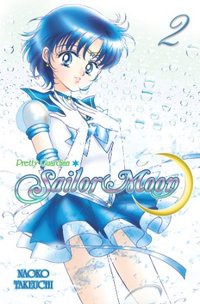
Vol. 2
(by Naoko Takeuchi, Kodansha Comics, $10.99)
FROM THE BACK COVER:
"Usagi Tsukino is a Normal Girl until she meets up with Luna, a talking cat, who tells her that she is Sailor Moon. As Sailor Moon, Usagi must fight evils and enforce justice, in the name of the Moon and the mysterious Moon Princess. She meets other girls destined to be Sailor Senshi (Sailor Scouts), and together, they fight the forces of evil!"
EVIDENCE FOR:
Okay, all those complaints about the early part of Sailor Moon being silly one-off adventures where the girls battle cupcake villains? I stand corrected. Volume 2 is where things quickly get good, with the back-story of the Moon Kingdom showing the true depths of Naoko Takeuchi's imagination. Part fairytale, part ancient myth, and wholly mind-blowing, the revelation of Usagi's previous existence lifts the series from simple fantasy adventure to time-spanning epic. The addition of Sailor Venus in this volume rounds out the cast of characters nicely, but it's the transformation of another—Mamoru, Tuxedo Mask, Endymion, whoever he is now—that truly turns the story around. With the stakes raised and the enemies getting tougher, Usagi must face her doubts about who her true friends and foes are. The artwork also gets an upgrade, with magical attacks becoming more impressive and a trip to the moon providing some unexpected space-age visuals. And while Takeuchi's style is often delicate and fantastical in presenting the story, it can also be remarkably chilling—witness the monstrous imagery of the Dark Kingdom's ruler, or the creepy expressions of a transformed Mamoru. Good and evil have both powered up, and so has the entire story.
EVIDENCE AGAINST:
It's one thing to add new depth to the series with the Moon Kingdom subplot. It's another to let it take over until every line of dialogue is some form of narration, exposition, or back-story. Readers may even start dreading scenes where any character is about to launch into a five-page spiel. And if it's not all the constant brushing-up on fictional moon history, then it's the interior monologue in Usagi's head clogging up the script; this story would be so much more streamlined if she didn't constantly share every single feeling she had about her friends and her destiny and the man of her dreams. This textual overload even overshadows certain key battles; apparently words do speak louder than actions sometimes. Also, despite all these complex developments, it's still hard to forgive the goofy logic of how the Sailor V video game and command center at the local arcade works. The artwork, meanwhile, frequently suffers from the same clutter as the story itself: there's just too much going on when everyone's attacking each other, with the pages looking more like screentone madness than an epic fight.
FINAL VERDICT:
The plot may be dense to the point of confusion sometimes, but nothing beats the feeling of seeing this world dramatically expand in the second volume. Expect a solid B's worth of good-versus-evil action.
SLAM DUNK

Vol. 19
(by Takehiko Inoue, Viz Media, $9.99)
FROM THE BACK COVER:
"Thanks to consecutive three-pointers by Mitsui late in the first half of the game against Ryonan High, Shohoku High ends the half down by only six points. Rukawa's still got plenty of strength left and he's going to need it to face Ryonan's ace, Sendoh. The pressure on Ryonan continues to draw fouls from them—can Shohoku exploit this and pull ahead? Or is Ryonan's coach Taoka just waiting for Shohoku to trip themselves up?"
EVIDENCE FOR:
With his appealing cast of fired-up characters, and precise, freeze-frame action shots, Takehiko Inoue captures a moment that all sports fans know and love: that swell of excitement when an underdog team turns it around and backs their opponent into a corner. That's Slam Dunk Vol. 19 in a nutshell, and it makes for one fantastic ride. Most notably, Inoue does more than just draw anatomically perfect basketball poses and update the score every few pages—he captures the emotion right there on the court, with intense facial expressions and in-your-face chatter as the characters react to each play. A few times, the artwork even elevates itself to imagery that would be near-impossible to catch in real-life sports: the entire Shohoku team spreading out evenly on defense, or Sakuragi catching a reflection of his opponent in his eyes. But these dramatic visuals would be nothing without the substance to back them up, and that's where Inoue stirs the pot with fierce rivalries (Rukawa vs. Sendoh is one to watch) and personal drama, such as the past struggles of Ryonan center Uozumi. Like all great sports stories, this continues to be a series that any reader can relate to.
EVIDENCE AGAINST:
Seeing Shohoku turn things around and get themselves fired up is indeed a thrill, but it takes several chapters to build up that momentum. As a result, this volume gets off to a slow, bumpy start, highlighting the part of basketball that even super-fans don't like very much: players repeatedly running up and down the court, not accomplishing much of anything. Sure, they're stressing the importance of playing good defense, but no one is here for a sports strategy lesson—we're here to read an intense sports manga full of acrobatic moves and dramatic highlights! Sad to say, but basketball players clanking shots off the rim and fouling each other is hardly dramatic or acrobatic. When the shots finally do start falling, Inoue makes another mistake by periodically interrupting the action with character flashbacks. While the back-story about Uozumi's drive to succeed is a crucial insight into his character, slotting it right into the middle of a game and stretching out an already very decompressed storyline may not have been the best idea. Heck, this volume starts out at halftime, and it still doesn't finish the game.
FINAL VERDICT:
Despite a rough start, the buildup of momentum, the engaging characters, and always-exciting artwork earn this volume a B+.

GIANT KILLING

Vol. 1
(by Masaya Tsunamoto and Tsujitomo, Kodansha, ¥543)
FROM THE ENCYCLOPEDIA:
"Experiencing a long streak of poor performances for several years in the Japanese professional football league, East Tokyo United (ETU) hires Takeshi Tatsumi as manager to try to break the curse that seems to have fallen over the team. Having spent three years in England, Tatsumi made the accomplishment of taking an amateur team to the top 32 teams of the FA Cup. Many consider him a bad choice and protest against this decision. They hold a grudge against Takeshi because they consider him a traitor for leaving ETU at the height of his career when he was still a football player. Unfazed by the negative mood that looms over the field, Tatsumi seems confident that he might be able to bring glory back to his team once again."
EVIDENCE FOR:
Calling it the Japanese soccer version of Moneyball might be a bit of an overstatement. Still, Giant Killing speaks a more sophisticated language than the "underdog schoolkid wins improbable championship" plot usually associated with sports manga. This is a realistic look at organized sports, where business deals and press conferences are as much a part of the game as actually playing it, and looking for undervalued talent (ah, so there's the Moneyball part) is a downtrodden team's best chance to succeed. There's even some witty self-awareness about the genre: Tatsumi has built his entire reputation on defeating heavily favored teams—"giant killing"—because clearly that's the plot of every inspirational sports story. This series, though, adds enough nuances o make the formula interesting: a fractured fanbase, an uncertain front office, and clashing personalities on the field. It also squeezes in some action-packed, eye-popping games, including the first-chapter match in England and a scrimmage session with a surprising result. Well-executed speedlines and dynamic poses make the sport exciting even for non-fans, and the wide range of character designs guarantees that you'll know and care about who's on the field—as well as off it.
EVIDENCE AGAINST:
A great sports story should start with a great main character—but in the case of Tatsumi, his roguish appeal only goes skin deep. In Volume 1, we learn little else about him other than that he likes to defy conventional wisdom and that lots of fans hate him for leaving Japan behind. The latter point in particular presents a major problem with how Tatsumi's character is presented: he's defined more by how people see him (the ETU front office, the fans, even the folks in England) rather than his own personal struggles and desires. Even in a direct argument with the team captain, Tatsumi just looks at him like a brick wall, unwilling to reveal any honest feelings. This impersonal approach also applies to the story in general—the logistics of pro sports, and the game's strategic maneuvers, get more attention than the characters themselves. In the artwork, one also finds a rather dry approach with the predictable rectangular panels; even the most dramatic action shots are framed in neat little boxes. It's almost as if the series is afraid to put on a full display of emotion.
FINAL VERDICT:
It may be hard relating to the characters at first, but for a realistic, sophisticated sports world (and some thrilling underdog victories), Giant Killing is hard to beat.

It's getting close to Christmas, and manga readers everywhere are wondering what good gift options there are out there! So don't be shy—send something in to Readers' Choice and let fellow fans know what you would personally recommend (or not recommend).
This week, contributor Steven Huynh returns to the column with a look at the love that dare not speak its name ...
KOI KAZE
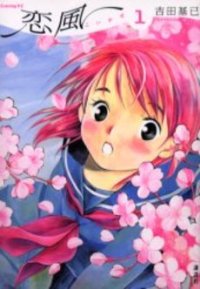
(by Motoi Yoshida, Kodansha, ¥530 ea.)
It's pretty easy for many to overlook Koi Kaze because of the nature of its subject matter and it doesn't help that incestuous relationships generally aren't portrayed all that seriously in manga, or even realistically for that matter. Koi Kaze does both and more with thoughtfulness and sincerity, and is as heartfelt and charming as any title you'll ever see.
The plot revolves around Koshiro Saeki and his sister Nanoka Kohinata who, having lived apart for years because of early childhood divorce, are permitted to be reunited in the same household because of various circumstances. However, they unwittingly meet by coincidence and unaware of who the other is, soon discover the beginnings of love with one another before discovering their blood relation. The two now attempt to live together as normal siblings while also suppressing their latent feelings.
One of the series' most defining qualities is the charming realism and honesty which Koshiro and Nanoka display. Being a romance, Koi Kaze is very much about the growing romantic tension between them. As Koshiro struggles throughout to deal with his romantic feelings for his sister, he continually tries to overcompensate by being the big brother his sister always wanted. This forges a very sweet sibling relationship between the two and it can be quite heartwarming watching their developing closeness. The story is crafted with such earnestness from the dialogue and internal monologues, to the charmingly humorous and innocent byplay between Koshiro and Nanoka.
However, it is when Nanoka begins to develop her own romantic affections for her brother that the gravity of the story becomes readily apparent. As both struggle to be honest about their true feelings to one another and to themselves as well, they are forced to also consider the serous implications that a relationship between them could have for their future. There is a very poignant kind of beauty in watching things unfold and never once does the drama ever feel cheap or manipulative because Yoshida takes such a thoughtful, mature, and sensitive approach to the plot. As well, both Nanoka and Koshiro show such a genuine and human quality in how they think, feel and interact with one another and because of how heartfelt and sincere their feelings are, it is very difficult not to become emotionally invested in our protagonists.
The artwork, with its soft graphite sketched look and feel, won't appeal to all. However, there are times when this approach creates wonderfully expressive scenes which captures the heart of the series perfectly. The anime's art is respectable in comparison, but lacks the same sense of grace and charm as Yoshida's. In addition the manga, being the source material, features many notable differences in various events and details, one of the most notable of which is the manga's ending. While similar to the anime in tone and direction, in some ways it's a more fitting one because it captures the beauty and emotional sentiment of Yoshida's writing and art with such poise.
The series won't be to everyone's tastes as many will be uncomfortable with its subject matter. As well, some scenes will likely come across as being more than a little creepy and disturbing to many. Scenes like these are done tastefully however, and can be just as sweet as the rest of the series. Ultimately, it isn't necessary to be in love with the idea of incest to be in love with Koshiro and Nanoka, or such a wondrously written and captivating love story. Yoshida never really pushes any kind of statement with Koi Kaze, nor are you forced to decide for or against as whatever opinions expressed by any of the characters are simply that.
It's unlikely you'll ever see the manga of Koi Kaze on the shores of North America any time soon, which is unfortunate. If you haven't read it, give it a chance. Even if you've seen the anime, it's still worth going through to appreciate many of the differences or even just the nostalgia factor. Either way, this is a series you'll fall in love with time and again because there are few as emotionally captivating, beautifully poignant, or as endearing as Koi Kaze.
Is there a hidden gem of manga you'd like to reveal to the world? Is there a piece of garbage that deserves to be bashed in public? Or is there a title that didn't get a fair grade here, and you want to set the record straight?
Now's YOUR chance to be the reviewer! Write a review of about 300-400 words (a little more or less is fine) and include:
- your name.
- Title of manga (and volume no., if applicable)
- Author/Artist
- Publisher
- Briefly describe the story, then explain why this manga is great, terrible, or in between. Be objective, but also be entertaining.
Then send it in to rtoreaders (at) gmail (dot) com (plain text format preferred). One review will be selected out of all the submissions and will be published in the next column. All types of manga and manga-inspired comickry are accepted, from past and present, from Japan and beyond—what matters is that it's the Reader's Choice! NOTE: Submissions may be edited for formatting and grammar.
discuss this in the forum (13 posts) |